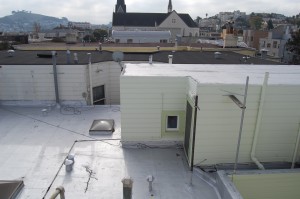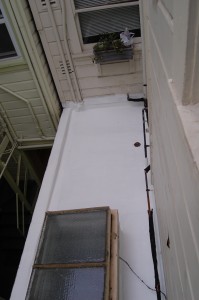One under-publicized but relatively simple approaches to combating climate change through building principles are white roofs. I agree with the basic logic behind white roofs, specifically that they can help keep buildings cooler by reflecting sunlight; it reduces the “heat island effect” associated with urban development; and by reflecting the sun’s rays it can help to cool the atmosphere. Think of your ice chest, the one you keep your beer in. What color is its top? Yeah, white. Same idea, just with houses.
Here are some shots from the top of one of my buildings in San Francisco:

Standard Tar and Gravel roof, very old school. And let me tell you, if you are up there on a sunny day, it is flippen hot. Here are my neighbors:
 Lots of different roof types and colors, the first looks like a silvery modified bitumen type, light colored but not white. The next is a black and then brown but still dark roofing material, and its the color alone that matters. Multiply those roofs over the whole city and that is some serious heat being trapped. According to many media outlets,so lets pick the LA Times, globally roofs account for 25% of the surface of most cities, and asphalt another 35%. “If all were switched to reflective material in 100 major urban areas, it would offset 44 metric gigatons of greenhouse gases” LA Times Sept 2008. Full science behind the claim can be found from the 2008 Edition of the Journal Climate Change.
Lots of different roof types and colors, the first looks like a silvery modified bitumen type, light colored but not white. The next is a black and then brown but still dark roofing material, and its the color alone that matters. Multiply those roofs over the whole city and that is some serious heat being trapped. According to many media outlets,so lets pick the LA Times, globally roofs account for 25% of the surface of most cities, and asphalt another 35%. “If all were switched to reflective material in 100 major urban areas, it would offset 44 metric gigatons of greenhouse gases” LA Times Sept 2008. Full science behind the claim can be found from the 2008 Edition of the Journal Climate Change.
This is in general well known stuff, pretty common sense, (see Ice Chest example above) and in general still not well appreciated. There are those who argue for really space aged approaches to climate change, like the Geoengineers who sound really cool with plans to do things like “mimicking the effect of large volcanoes by spraying sulfur dioxide into the stratosphere to diminish solar radiation”. But for me, I prefer practical things that can be done right now.

Well, it won’t save a gigaton, maybe a few hundred pounds over the next 20 years, but my contribution on the eve of Copenhagen is a new white roof. It was a necessary repair, the roof was leaking, and it has real environmental value too. When the time comes, I will whiten up my tar and gravel roof above as well. And that is how it should be. If you own older buildings like I do, or an older home, eventually you will need to put on a new roof. When you do, do your part, make it white.
{ 0 comments }